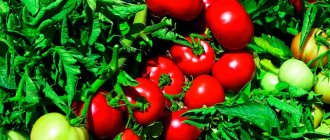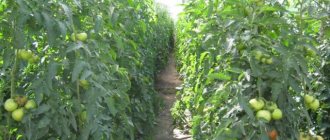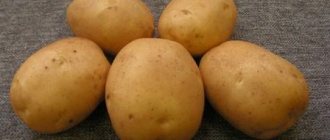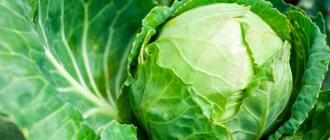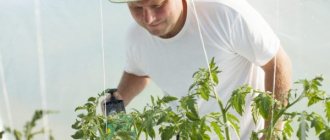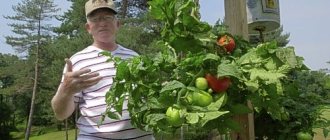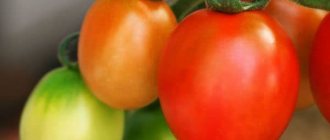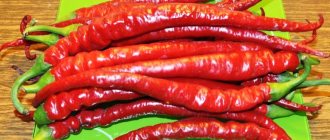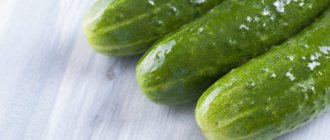In the conditions of central Russia, the successful cultivation of many varieties of tomatoes in open ground is unlikely. This is hampered by short summers and frequent frosts. It is difficult for novice gardeners to get a good harvest without a greenhouse. Therefore, breeders have put a lot of effort into breeding crops that can cope with all negative external factors.
Thanks to the efforts of agronomists, the Moskvich tomato variety was developed. This culture is resistant to frost, temperature changes and is unpretentious in care.
Description of the Moskvich tomato
The fruits are medium in size and red in color. The taste is sweet and sour, classic for tomatoes.
The variety was bred for cultivation in open ground in the extreme conditions of the northern regions. This is one of the few varieties that, withstanding low temperatures, produces a good harvest within three months after sowing the seeds.
Moskvich bushes are determinant. On average, the plant height reaches only 40 cm.
Advice ! Due to its low growth, the Moskvich tomato is suitable for cultivation not only in a greenhouse and in open ground, but also on a balcony and on a windowsill.
Features of the variety
Moskvich tomatoes are a variety bred specifically for cultivation in the extreme conditions of the central zone of our country. The fruits of this crop are medium in size and uniformly red in color.
The taste of tomatoes is classic sweet and sour. The fruits are fleshy, with a small number of seeds. They contain up to 6% dry matter.
The main feature of the variety is frost resistance and ease of care. The tomato is not afraid of night frosts and is suitable even for the “lazy” gardeners.
Moskvich has immunity to a number of plant diseases. It is rarely affected by late blight, which is considered one of the most dangerous tomato diseases.
Tomatoes are suitable for canning, preparing tomato sauces, juices and hot dishes. Moskvich fruits can be used raw. Therefore, the variety is considered universal.
Description of the bush
The Moskvich tomato variety is low-growing, determinate, standard. Plant height indicators differ from one seed manufacturer to another, ranging from 28-50 cm. The main shoot is strong and thick. The first brush is formed over 6-8 sheets, the next ones are laid through 1-2 plates.
Few stepsons are formed, and an average number of leaves. They are small, dark green, highly corrugated. The brushes are short; in total, from 3 to 6 of them appear on the bush during the growing season.
Description of fruits
The resulting harvest of the Moskvich tomato variety is presented in the form of flat-round and round tomatoes with a rich red color when ripe. In the phase of technical ripeness - brown-green. Near the stalk there is a shade of intense green. They are not large in size, but for an early variety they have a good weight - 65 - 90 grams.
The fruits are used for table purposes and are universal; they are good either whole, put in a jar, or in the form of a salad or for making juice.
Basic qualities of fruits
The fruits are round and flat-round, red in color at maturity, weighing 40-75 grams, good (for early) taste. These tomatoes are universally used - they are mainly used for processing into tomato products, pickling and canning.
Planting pattern : 50 x 40 cm, planting density - 7 - 8 plants per 1 sq. m.
Productivity of Moskvich tomato : up to 4 kg of fruits per 1 sq. m (subject to agricultural technology).
Advantages of the variety : early and uniform formation of fruits, cold resistance, resistance to temperature changes, high fruit set in unfavorable weather conditions.
The variety is resistant to fusarium, verticillium wilt, alternaria, rot, and late blight.
In 1976, this tomato was included in the State Register of the Russian Federation for the Northern, Northwestern, Central, Volga-Vyatka and East Siberian regions for cultivation in open ground.
Originator of the variety : Institute of General Genetics named after N.I. Vavilova
Tomato Moskvich: fruit characteristics
Tomato Moskvich: photo of variety
Let us dwell in more detail on the description of the fruits of the Moskvich tomato variety themselves. One copy usually weighs from 60 to 80 grams. If you follow all the basic rules of agricultural technology, you can grow 100 gram specimens. The color of these tomatoes is bright. The shape of the fruits is round, slightly flattened. The taste is at a high level. There is a good balance of sugar and acidity. As for the sugar content, it is usually 3%.
In terms of application, such tomatoes are universal. They can perfectly complement a fresh salad. They are also suitable for making various marinades and pickles. Moskvich tomatoes can keep their shape well. They do not have the property of cracking. In addition, you can make very tasty tomato paste from these tomatoes. If you grow this variety in the northern regions, then it is best to remove tomatoes that are not fully ripe from the branches. And then wait for complete ripeness.
The Moskvich tomato variety is well suited for commercial purposes. Because thanks to the fairly dense peel, the fruits tolerate transportation well. At the same time, they do not lose their presentation. Such fruits can be stored well. And also ripen, lying on the window sill.
The Moskvich tomato variety is quite capable of adapting to changes in climatic and weather conditions. It also has strong immunity against various diseases and pests. These qualities make this variety very popular among gardeners throughout the country. In addition, such tomatoes can be successfully kept at home. Good survival rate, as well as compact sizes, contribute to this.
Area of application of fruits
Moskvich tomatoes have a rich, sweetish taste with a fleshy, juicy texture and soft skin. They are suitable for preparing hot dishes, sauces, and salads. They can be used for pickling and salting, and processing into tomato juice.
Reviews from gardeners
Both beginners and experienced gardeners like Muscovite. It is especially appreciated by residents of the northern regions.
Nikolay, Vologda: “I am pleased with the unpretentiousness of the Moskvichka. I can’t devote much time to the garden, but I grow tomatoes every year. This variety does not require special attention, which makes me very happy. “Tomatoes are very tasty, every year we can them for the winter and eat them fresh.”
Lidia Mikhailovna, Saratov: “I have long heard from experienced gardeners about the Moskvich tomato. I decided to try it at random and now I prefer this variety to all the others. A very productive tomato, I recommend it to everyone!”
Elena Korotkova, Novodvinsk: “I live in the northern region. In our conditions it is not easy to grow a tomato crop. I found a variety called Moskvichka that is resistant to our cold weather. For me, growing tomatoes without greenhouses was a real discovery. I will never give up this variety!”
Characteristics of Moskvich tomato
All characteristics of the Moskvich tomato correspond to the climatic realities of our country. This is one of the few varieties that can be grown in open ground in all regions of Russia.
Description of the variety:
| Parameter | Indicators |
| Bush type | Determinant. The maximum height of the bush is 50 cm. Standard. Medium leafy. The leaves are corrugated, small in size. The first inflorescence appears above the 8th leaf, the rest every 2 leaves. The growth of the bush stops after the formation of 3-4 brushes. |
| Growing method | Bred for cultivation in open ground and in unheated greenhouses. |
| Productivity | High. From one bush you can collect 2-3 kg of fruit. For one sq. m you can plant 6-8 bushes. Up to 7 fruits are formed on one brush. |
| Fruit | The tomatoes are bright red inside and out, possibly with a greenish spot at the base. The shape is round and regular, with slight ribbing at the base. The weight of one fruit varies between 60-80 g. Some specimens gain weight of 100 g. The taste is classic sweet and sour. Fleshy, dry matter content – 6%. The fruits have 5-6 chambers, with a small number of seeds. |
| Transportability | High. They have a tough skin. Thanks to it, tomatoes do not crack during transportation and in the heat. Can be stored for more than a month. |
| Ripening time | Early ripening variety. The first fruits ripen three months after sowing the seeds. Fruiting continues until autumn |
| Disease resistance | Fusarium wilt, tobacco mosaic, Alternaria. |
Plant care
As the description shows, these tomatoes are not at all picky about their living conditions, so the process of growing and caring for them is as simple as possible. Since the tomato bushes are low and the stems are strong, they do not need to be tied up or pinched. But there is a clever way to get early fruits. To do this, it is enough to remove 1-2 lower leaves to ensure sunlight reaches the ripening tomatoes.
You can divide all the seedlings into two groups: remove the stepsons from one part, and leave the second untouched. This way you will get both an early harvest and a large number of late fruits. Since this variety is disease-resistant, you can grow tomatoes without the use of chemicals. Thanks to this, your harvest will be environmentally friendly.
Features of cultivation
The Moskvich tomato variety was bred by Russian breeders and zoned for the regions of Siberia, the Volga region, the North-Western and Central regions. Growing in open ground or under film is recommended. The collected fruits are well stored and can be transported. Tomatoes picked green ripen successfully at room temperature.
Tomatoes of the Moskvich variety, like other early tomatoes, are more convenient to grow in seedlings. Before sowing, the seeds are soaked in a growth stimulator, which ensures excellent germination. The soil is made up of a mixture of garden soil with peat or humus. The seeds are sown at a depth of 1.5-2 cm, sprinkled with peat, and sprayed with water. For successful germination, a temperature of 23 to 25 degrees is required. After emergence of seedlings, it is reduced, and containers with seedlings are placed in bright light.
Young tomatoes need long daylight hours and moderate watering with warm, settled water. When the first true leaves develop on the seedlings, they are picked and then fed with liquid complex fertilizer. Plants intended for planting in open beds must be hardened off by taking them out onto the veranda or balcony for several hours.
Transplantation into the ground begins in the second half of May-early June. The soil should warm up; at first, young plants can be covered with film. The bushes are planted at a distance of 30-40 cm from each other, with row spacing of at least 60 cm. It is not necessary to tie or shape them; for better insolation, you can remove the lower leaves.
Water the tomatoes abundantly, but not often, using only warm water. Every 2 weeks, the plants are fed with complex fertilizer with a predominance of phosphorus and potassium.
It is very important to choose the right soil, both for planting seedlings and for adult plants in the greenhouse. An article about types of soil for tomatoes will help you figure this out. You will also find on our website information on how to prepare the soil for tomatoes yourself.
Farmer reviews
Reviews about the Moskvich tomato are contradictory. Residents of cold regions of Russia praise it more.
Beskrovnaya Maria, Arkhangelsk: “I have been growing Moskvich for several years now. This is one of the few tomatoes that can take root in open ground in our area. I use the fruits mainly for preservation. For fresh consumption, I grow tomatoes in a greenhouse.”
Kravets Oleg, Zelenograd: “On the advice of a friend, I tried the Moskvich tomato. An excellent variety for growing in the country. Unpretentious and needs minimal care. I can’t say that I really liked the taste of these tomatoes, but for canning it’s just the thing.”
Vasily, p. Udomlya: “I am a busy person, I work a lot. I can only go to the dacha on weekends. I want to grow my own tomatoes, but I don’t have time to bother with the garter and pick off the shoots. This year I sowed the old proven variety Moskvich. There is no need to cover it or reveal it. I fed it 3 times during the season, and the rain, of which there was a lot, watered the tomatoes for me. I thought that I wouldn’t wait for the harvest. But then the sun came out and the tomatoes began to sing together. In a word, I’m pleased with the variety.”
Growing seedlings
Sowing of planting material for seedlings is carried out 55-60 days before planting tomatoes in open ground. For the Moskvich variety, the optimal time for growing seedlings is the end or mid-March.
How to choose containers and soil
There are two options for sowing seeds. Each of them has its own advantages and disadvantages.
Seed sowing options:
- One large container. You can sow all the planting material in one large container - a special tray or box, cut-off juice boxes or a cake stand. In this case, after the plants have germinated, they will have to be planted in separate pots. The advantages of this method are its cost-effectiveness and ease of growing seedlings. The disadvantage is the need for early picking.
- Separate containers. You can sow the seeds directly into individual cups or peat tablets. In this case, they will not be replanted for a long time and will not injure the root system. The disadvantage of this method is its cost, especially when using peat tablets.
To plant plants, you can use not only store-bought pots, but also homemade containers made from plastic cups, cut-off bottles, etc. However, the container should not be too small.
To prepare the soil mixture yourself, take turf soil and humus in equal proportions. You can add one part of ash and one matchbox of soil fertilizers to the mixture.
The prepared soil must be disinfected. To do this, the earth is calcined in an oven at a temperature of 100 degrees or poured with boiling water.
Preparing the seeds
Preparing the seeds will speed up and improve their germination. Therefore, this point must be taken seriously.
Preparation of planting material:
- Soak the planting material in salted water for 30 minutes. Remove any floating seeds. They won't rise.
- The seeds that have sunk to the bottom need to be washed and soaked for another 20 minutes in a light pink solution of potassium permanganate. This will disinfect them. Make sure that the potassium permanganate crystals are completely dissolved, otherwise they will burn the seeds.
- Place the seeds in a growth stimulator. To do this, soak pieces of gauze in the solution and wrap the seeds in them. This will speed up the germination of tomatoes.
- Dry the seeds after soaking. This can be done with a paper towel.
Growing Moskvich tomatoes
The maximum return from cultivating the variety is achieved by following a few simple but important rules. Attention to detail often helps to achieve record results.
Planting seeds
When growing Moskvichka tomatoes, it is not necessary to renew the seed material.
For seed selection, ripe fruits are taken. They are cut and kneaded until smooth, covered with gauze and left until the mixture begins to ferment. The seeds are removed after the formation of bubbles and a white film on the surface. Then they are washed, dried and stored in a paper bag until sowing. Moskvichka tomato is planted in late March or early April.
Before planting, the seeds are disinfected to eliminate the appearance of pathogens. They are placed for 20 minutes in a 1% solution of potassium permanganate, and then for 18 hours in a solution of a growth stimulator (Epin-extra or Zircon).
Important! Seed germination will be higher if you sow them immediately after disinfection.
The depth of the planting container must be at least 7 cm and equipped with drainage. For the seed mixture, peat soil, vermicompost and sand are usually used in equal quantities. Seeds are planted to a depth of 1.5 cm, 2 grains in each cup.
The seeded containers are moistened and covered with plastic film to create a greenhouse effect. Shoots appear after about 5 days, at this moment the film is removed and the seedlings are placed in a bright place, preferably on the south side. Further cultivation continues at humidity parameters of 30–60% and temperature +22…+24 degrees.
Seedling care
When the soil in the cups with seedlings dries out, it needs to be watered. You can add melt water when watering, and also use a stimulator (HB101).
After a month and a half, the seedlings are ready to be transplanted into open ground, but they can only be planted after the ground has warmed above 15 degrees.
Important! Muscovite is a light-loving variety, so you need to choose a well-lit place on the site, avoiding shade and partial shade.
Agricultural technology in open ground and greenhouses
Plant seedlings in prepared soil. To do this, in the fall, when digging the future bed, humus or compost is added to the ground, and superphosphate is also added there.
For each bush, dig a hole and moisten it with warm water. After planting, the ground around the bushes is mulched with crushed straw.
Watering is carried out so that the beds do not become waterlogged or dry out. Every two weeks the bushes need feeding. Alternate organic and mineral fertilizers.
Since the Moskvichka variety is low-growing, there is no need to tie up the bushes. They do not need stepsoning either.
Protection from diseases and pests
The Muscovite tomato is considered one of the most disease-resistant nightshades, but due to its precocity, it can be susceptible to late blight. The disease can be avoided by using Fitosporin. This is a biological product that does not cause toxic effects. You also need to loosen the soil and weed out weeds in a timely manner. To prevent diseases, it is recommended to remove the lower leaves from the bushes.
Read also Strawberry is a shrub or herbaceous plant
Diseases are not the only problem with tomatoes. Various pests love them very much, which causes damage to the crop. The Muscovite tomato is most often attacked by the Colorado potato beetle, spider mites, thrips and aphids. Insecticides are used to control insects.
It is recommended to start treatment at the first symptoms of plant damage. Spraying must be stopped during the flowering period, and 40–45 days before ripening, treat again. Traditional methods include garlic solution and ash.
Transplanting
Before planting tomatoes, you need to prepare the soil. To do this, each square meter of land must be sprinkled with 40 g of superphosphate, 15 g of dry chlorine and 20 g of ammonium nitrate and dug up.
The holes are dug in a checkerboard pattern. The distance between rows should be 60 cm, the distance between plants 30-40 cm.
The depth of the holes should be approximately 35 cm. When planting plants, their lower leaves are removed.
Tomatoes are planted in the holes along with a lump of earth that was in the pot. The depressions are filled with soil.
Preparing the beds
So, a place for tomatoes has been chosen. How to properly prepare beds for them? It is best to start doing this in the fall. The selected area is dug up to a depth of about 30 cm and fertilizers are added to the soil. This can be humus, compost or mineral supplements (superphosphate, potassium salt).
In the spring, the bed for tomatoes is dug up again, adding 55 g of superphosphate, 15 g of potassium chloride and 20 g of ammonium nitrate per square meter. Experienced gardeners do not recommend using cow manure as a fertilizer for tomatoes. When it is used, plants begin to actively develop green mass to the detriment of flowering and fruiting.
Planting seedlings in the ground
The land in the area allocated for growing tomatoes has been prepared since the fall. It is carefully dug up, weeds are removed and a bucket of humus is added to each square meter, since Moskvich tomatoes are very fond of fertile soil. Spring preparation consists of harrowing and adding wood ash in the amount of 100 g per 1 m2 and 1 tbsp. l. potassium
If some vegetables were previously grown on the site, then you need to pay attention to the fact that you should not plant tomatoes after potatoes, bell peppers, eggplants, and peas. These plants suffer from the same diseases and attract the same pests, so there is a high probability that fungal spores or larvae of harmful insects will remain in the soil from their predecessors
It is best if pumpkin or cabbage grew on the future tomato plantation.
As soon as the soil warms up enough and its temperature is not lower than +15°C, the seedlings can be planted in the ground. The bushes of the “Moskvich” variety are very compact and low, but if they are not pinched, they can grow to the sides for a considerable distance. Therefore, the gap between plants in a row and the interval between rows should be at least 60 cm.
A separate hole is dug for each sprout, and the soil in it is spilled with warm water.
Then carefully transfer the plant along with the earthen lump into the hole, sprinkle it with earth, and lightly compact it. The ground around the plantings can be covered with some kind of mulch: dried lawn grass, sawdust, tree bark
It is better to shade the plants for a while with covering material.
Landing
Moskvich tomatoes are grown in seedlings. For the substrate, peat, humus and garden soil are mixed. Having placed the seeds on the surface, they are covered with a small layer of soil and carefully watered. Cover with film and leave the container until the first shoots appear. The optimal temperature is 25°C. When the sprouts sprout, remove the film.
To prevent the appearance of rot, it is recommended to treat the plantings once with Fitosporin. The working solution is prepared from 1 tsp of the drug and 4 l of water. When the tomatoes have two true leaves, pick them. After 14 days, the first feeding is carried out. To do this, dissolve 1 tablespoon of urea in 4 liters of warm water. The procedure is repeated after 2 weeks.
Landing in the ground
Transplantation to a permanent location is carried out at the end of May, when the earth has warmed up. Given the plant’s love for the high nutritional value of the soil, the soil is pre-fertilized. The first time this is done is in the fall. At least 25-28 kg of organic humus is added per meter of plot. After spring digging, 100 g of superphosphate and 2 g of potassium chloride are evenly scattered and covered with a rake.
Steps to take when landing:
- forming holes at a distance of 30*40 cm;
- distribution of seedlings and straightening of roots;
- leveling the soil surface and mulching.
Diseases and pests
The Moskvich tomato is not susceptible to many plant diseases. But for some diseases, tomatoes will still have to be treated.
Late blight occurs in conditions of excessive humidity. Muscovites rarely suffer from this disease. To prevent its development, you can use the “Barrier” product.
Dry spotting is caused by a fungus that attacks the plant at elevated temperatures. Treating tomatoes with copper preparations will help in the fight against this disease.
Necrosis of a tomato stem without timely treatment can lead to the death of the plant. To get rid of this problem, use “Fitolavin”.
